DATELINE – April 27, 2022 – Kaufman County
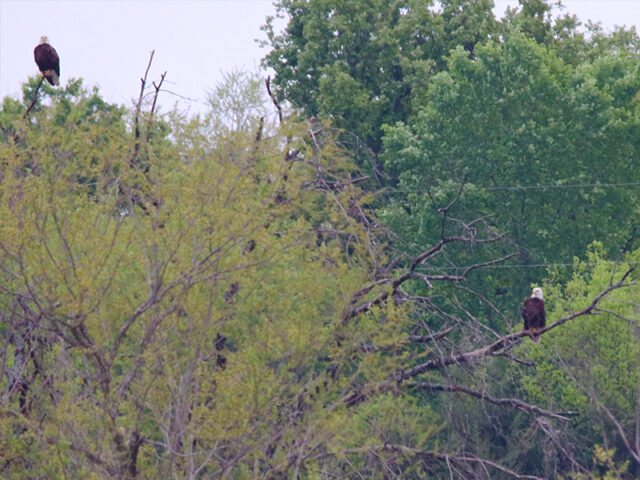
A few weeks ago I received an unexpected email that turned out to be quite a pleasant surprise. The email was from a Kaufman County landowner who had some interesting news he wanted to share.
It seems that for the better part of a year a pair of Bald Eagles—a male and a female—had been frequenting his east Texas property; spending their days hunting his 5 acre stocked lake.
In a recent development, the eagles had taken a particular interest in the remains of a mess of cleaned fish he had dumped back into the shallow water on the bank of his small lake. He wanted to know if I’d like to come out and see this for myself, and maybe take a few pictures…
Would I? Ha! Would I ever!
I made the drive out to Kaufman County under the cover of darkness, in the wee hours of the morning. I wanted to be on site before dawn so that I could set up without alerting the eagles.
I arrived at around 6:00 am, a full 40 minutes or so before sunup. I brought with me my trusty chair blind—a tool that has become invaluable in my pursuit of wildlife photography. My plan was to setup near the lake shore and wait for the eagles to arrive with the breaking of dawn.
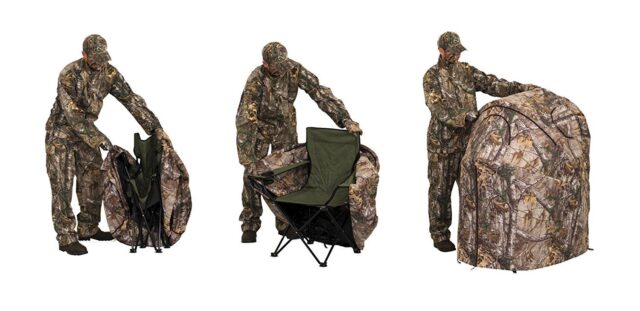
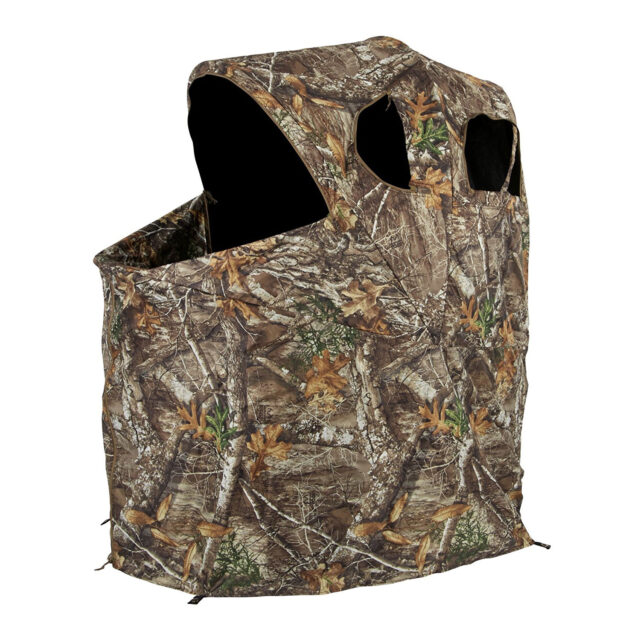
its zippered windows open
In the darkness, I discovered a problem with my tactic. I couldn’t tell if my field of view would be clear of vegetation or not. Nothing can ruin a picture like a stray twig or branch intruding into a wildlife photograph, and I was determined to avoid that eventuality if possible.
My solution was to push the boundaries of discretion. I decided to place my chair blind just as close to the spot where the eagle was expected as I judged was even remotely prudent. In the black of night it was the only way to be sure of a clear field of view. It was a risky move—if it worked the view of the eagles should be spectacular. If it was too clumsy and intrusive the eagles might decide to play it safe and stay away. With only one way to be sure I climbed into the blind and pulled the hood over me as the eastern sky behind me was just beginning to glow a soft, pale pink.
It was shaping up to be a cool, comfortable spring morning, which was a good thing as I expected to have an extended stay in the chair. I had with me my Canon Digital SLR Camera with a Sigma 150-600mm lens attached. It was a big and heavy rig that would give me plenty of reach for the types of pictures I was hoping for. The sky was clear of overcast, and I could tell from the warm glow developing on the treetops across from me that I would have beautiful lighting for this photography session. Things were starting to fall into place. I leaned back in my chair and settled in for the long haul, and I waited. And then I waited some more.
As the light gathered with the coming dawn, I spent a moment taking stock of the wildlife already at the lake. Across the way, near the dam, a cormorant perched on a piece of deadfall jutting up from the water. A quintet of Domestic Mallards patrolled the shoreline, back and forth. Spotted Sandpipers prodded the sandy beach. Behind me I could hear the honk-a-lonk of a pair of Canada Geese who had spend the night protected by the lake waters. From the woods I could make out the haunting sound of a Chuck Will’s Widow calling again and again. Turtles—Red-eared Sliders and big Spiny Softshells—came up to feed on the fish entrails. On occasion they were joined by a bold Diamond-back Water Snake doing the same. There was plenty to see and hear.

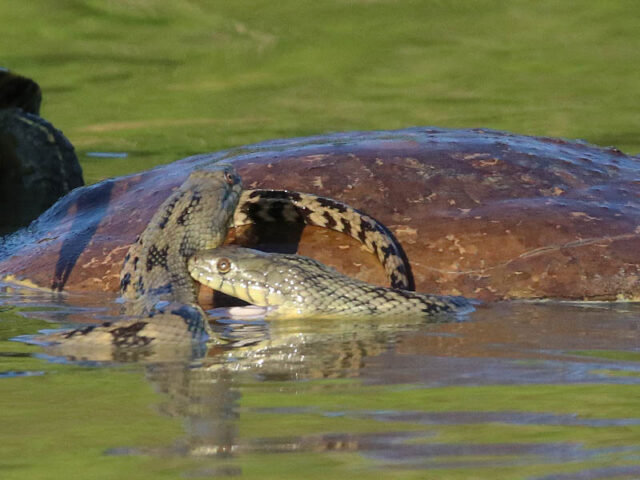
At around 6:30 am I noticed a shadow zoom across the surface of the lake water. I looked up just in time to see an eagle fly across the width of the lake and land in a tree on the far side. He perched out in the open on a dead, bare branch, but he was decidedly too far away for quality pictures—even with my powerful zoom lens. So, I sat back and continued to wait. And wait.
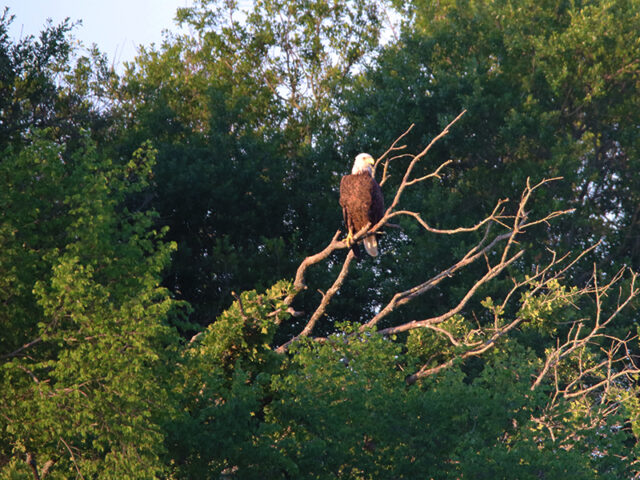
After about 45 minutes the eagle left his perch and leapt to the air. I felt a moment of excitement, as the big, beautiful bird seemed to be heading my way. But at the last second he veered off and landed in another tree on the opposite side of the lake’s earthen dam. He was closer now, and in a better place for me to keep and eye on him, but he was still a little too far away for the kind of pictures I was hoping for. Again I made myself comfortable and waited. And waited some more.

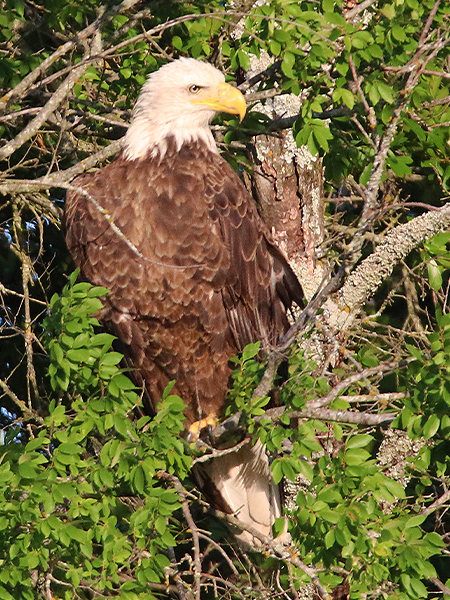
I hoped he would get closer!
Another 45 minutes passed before the eagle moved again. This time the big bird circled out and back in, finally coming to rest within the branches of tree located about halfway between his first two perches. He was a little further away now, and the trees here were fully leafed out. Most of the time the eagle was well hidden by the vegetation and deep shadows. I was beginning to worry that I had overstepped with my placement of my chair blind. Maybe I had set up too far out in the open and too close to the lake. But there was nothing I could do about it now, if I tried to move I would certainly spook the eagle. I simply had no choice but to continue to wait. And wait.
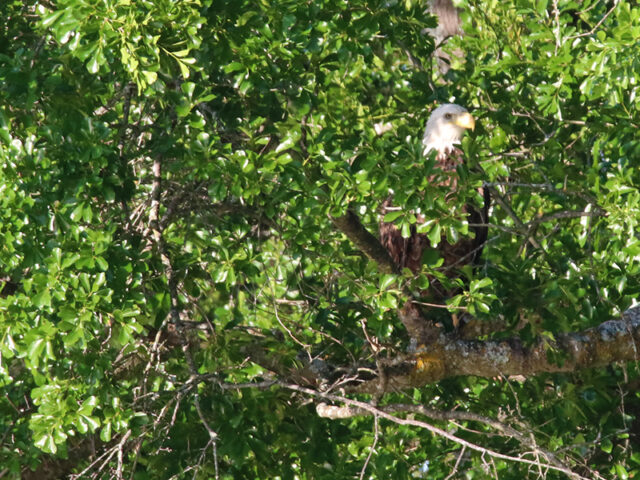
It was difficult to keep tabs on him amidst all of the leaves.
Forty-five more minutes ticked off the clock while I sat patiently in anticipation. This time when the eagle took flight he was on a beeline and headed directly at me. I held my breath as the big bird closed in only to juke at the last second. He disappeared from view somewhere to the left of my blind. I sat there kinda stunned. I wasn’t sure what to do next, but I was beginning to worry that I was going to miss out on my opportunity to get pictures of this beautiful bird.
Then I heard an unusual squawk coming from just outside the blind.
I slowly unzipped one of the windows on the left side of the blind, creating an opening just big enough to peep out of. I leaned over to take a look-see and there on the ground—near enough to touch—was our friend the Real Texas Bald Eagle. So close and yet so far away. I was sure that if I unzipped the window further in order to open it fully, and then moved my camera into position for pictures, that I would certainly frighten the eagle away. I was frozen by indecision.
Coincidentally, at that very moment the eagle simultaneously caught the attention of a murder of crows and the Canada Geese pair who had spent the night on the lake. The crows began dive-bombing the eagle from the air, while the two angry geese charged in across the lake flapping their wings furiously and honking loudly all the way. The eagle quickly bugged out, took to the air, and again disappeared into the trees growing up in the middle of the dam.
I was more than a little crestfallen. Had I just missed my best chance for pictures?
But then a couple of interesting things happened. First the two geese, who had taken to the air in pursuit of the eagle, stayed airborne and then proceeded to fly away to the south. Next, the group of crows decided to make a move on the fish entrails. This brazen action was more than the eagle could stand. He rocketed across the lake and swooped down on the crows, scattering them to the four winds. The eagle continued on until he disappeared off to the left of my blind once again.

The eagle was not happy about this development!
I crossed my fingers and glanced out the still open peephole. There he was, on the sandy beach, doing that weird waddle-hop eagles do while walking on the ground. And more importantly he was moving in a direction that would bring him right into my field of view. I propped up my camera, pointed it where I expected him to appear, and waited with bated breath.
Suddenly the big bird filled my viewfinder! The eagle took his sweet time, my arms were aching with the weight of the camera, but the big beautiful bird was finally right in front of my chair blind. I started snapping photographs furiously. See the pictures below for all that happened next!
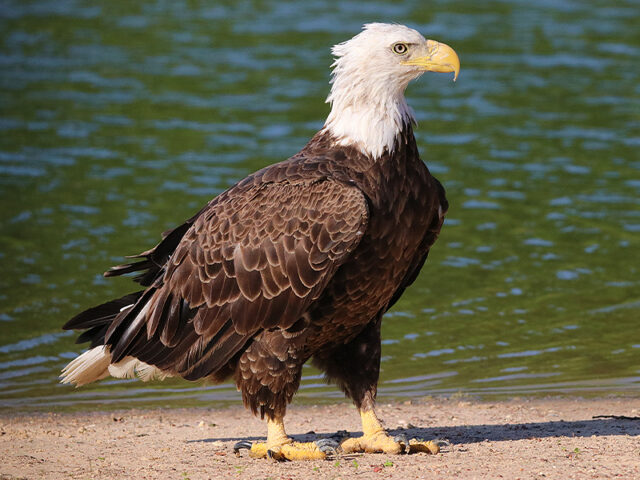
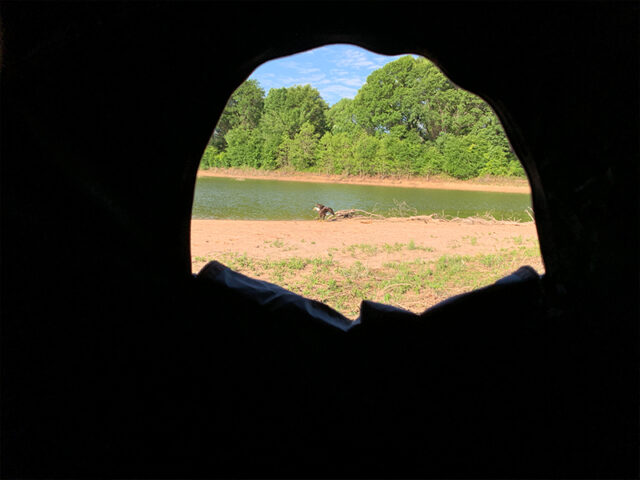
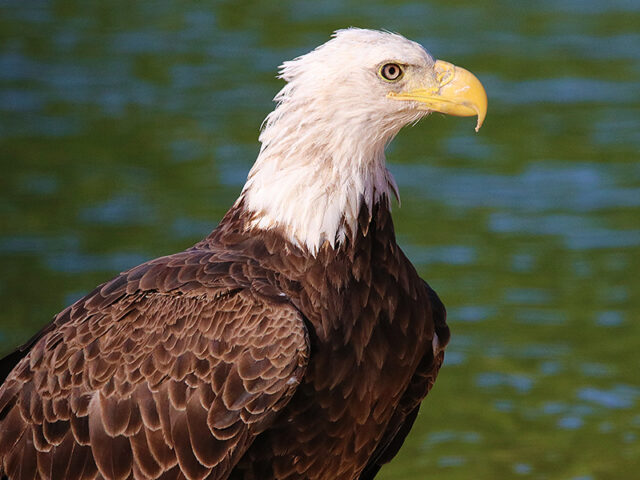
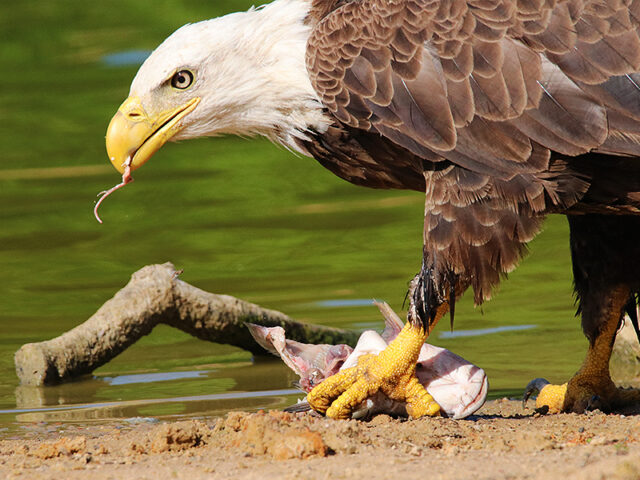
Here the eagle is seen feeding on the fish remains
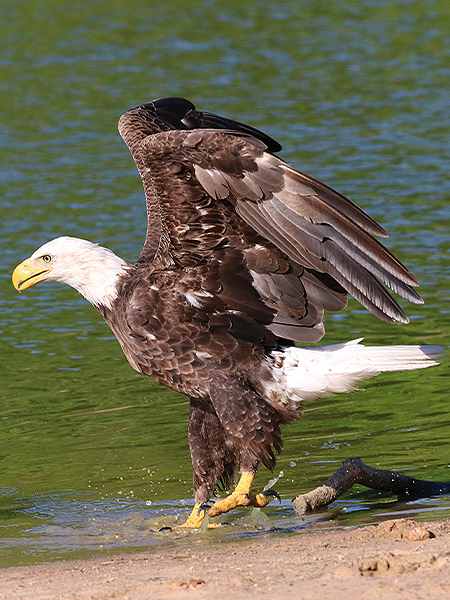
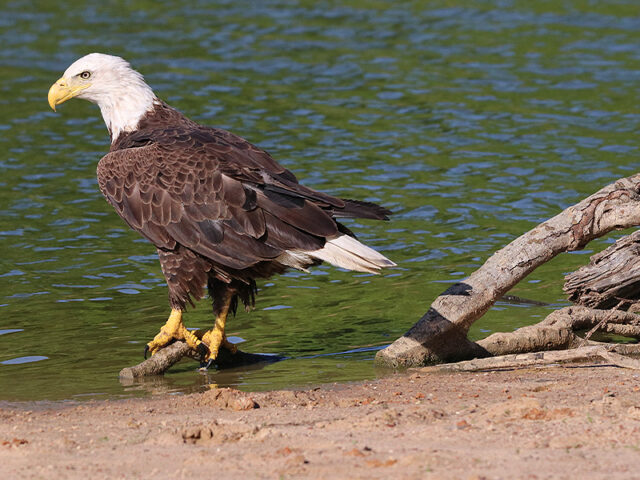
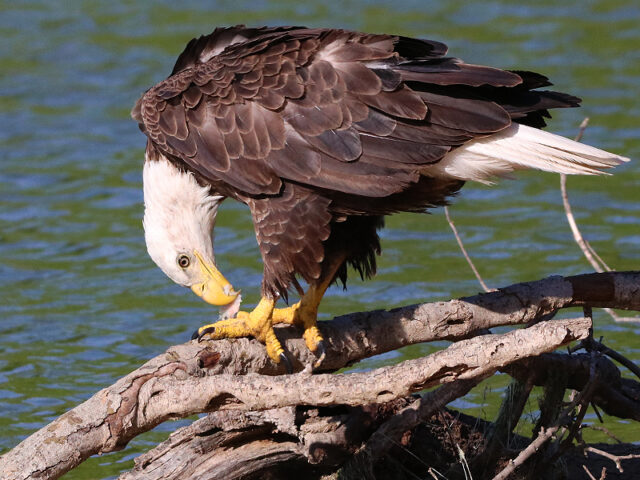
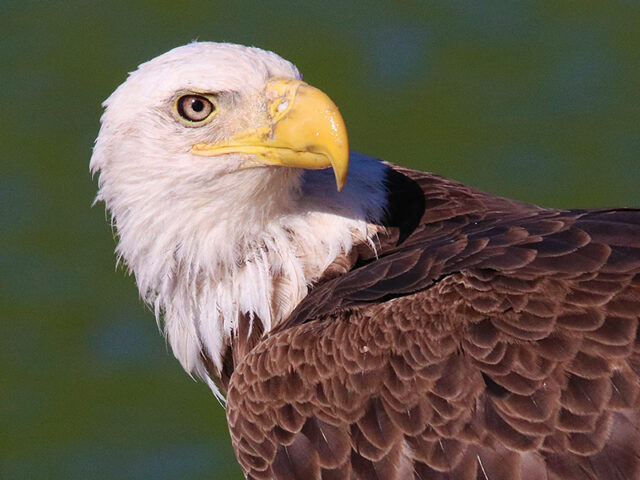
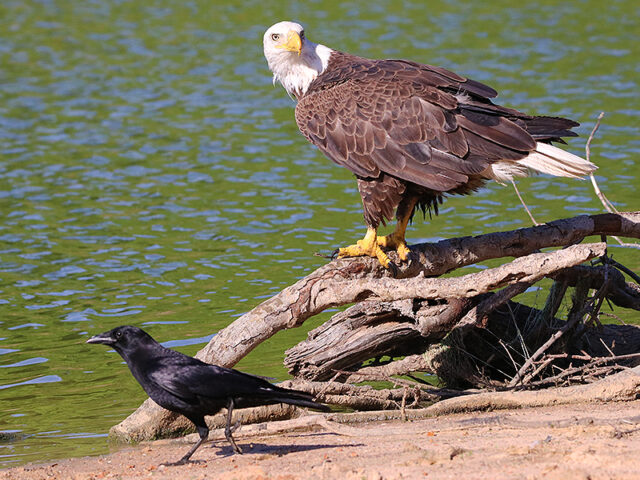
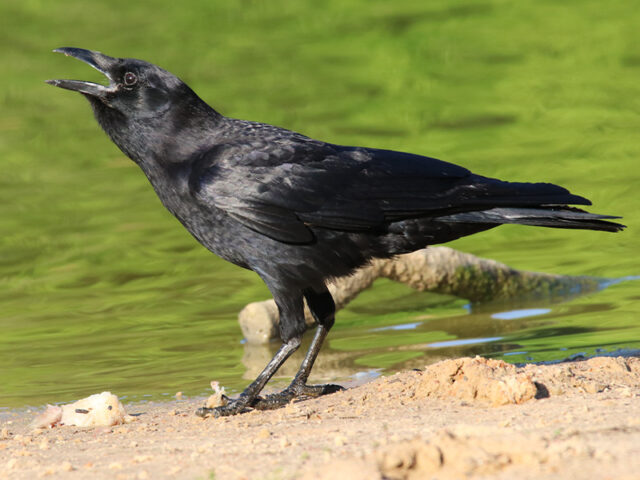
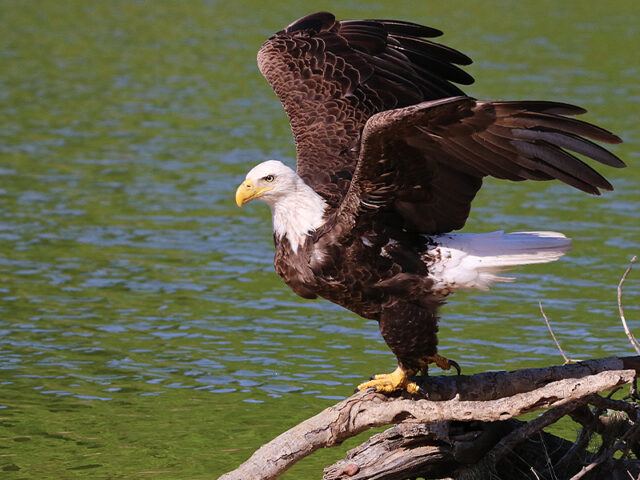

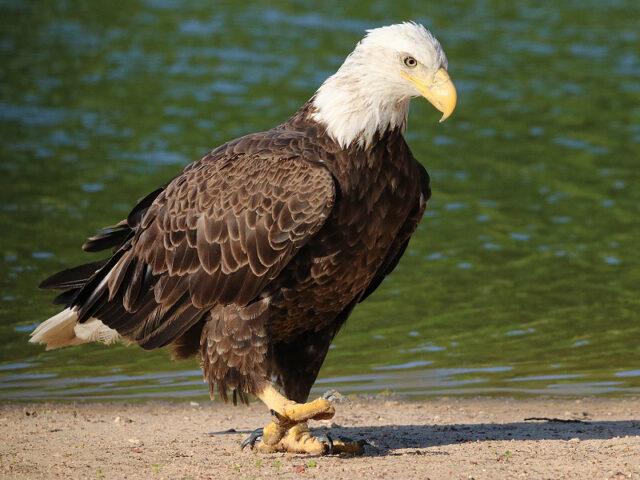

The eagle was able to feed undisturbed for the better part of an hour. I was beginning to think he was never going to get full, when I noticed a number of new shadows zooming across the ground and tracing out circle. A quick glance up showed that the sky was filling with Turkey Vultures.
Suddenly a trio of these big (but still notable smaller than the eagle) birds dropped in on the scene simultaneously. As the vultures closed in on the eagle’s position, he squawked loudly in protest and the begrudgingly gave ground. The big Bald Eagle took to the air, cried out one more time for good measure, and then fled the scene. He had his fill, and what remained was not worth fighting over.
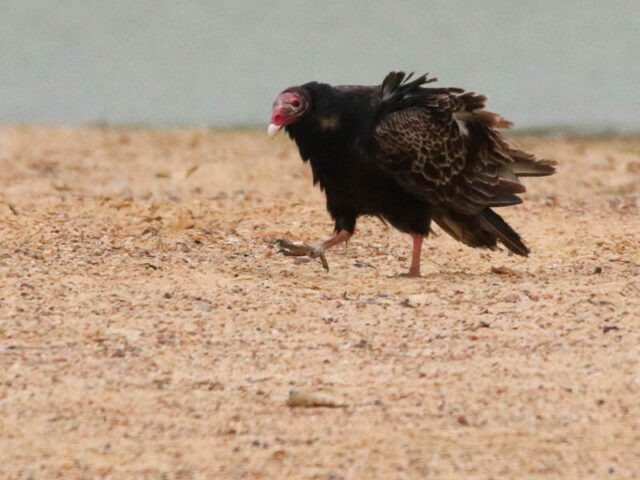
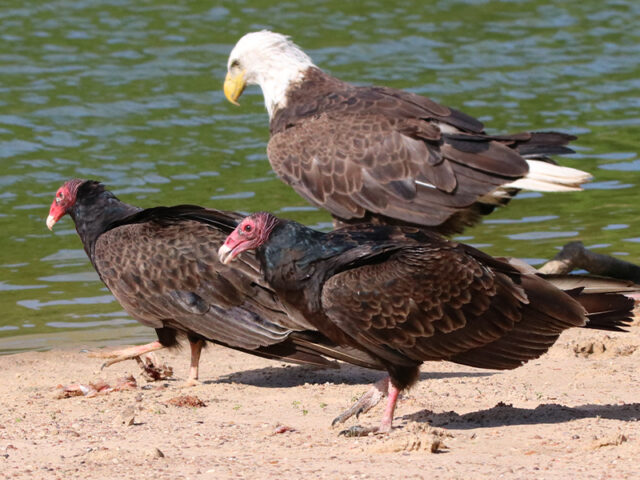
so he fled the scene without a fight.
It probably helped that he was full from gorging himself all morning.
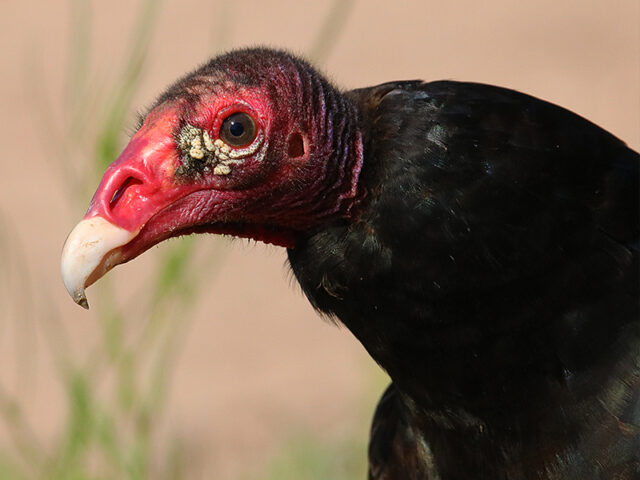
Soon the first three vultures were joined by several more. Then a pair of adult Crested Caracara showed up and started throwing their weight around in an attempt to get closer to the food. Next a juvenile caracara—dressed in a much duller plumage than the adult birds—joined in the melee.
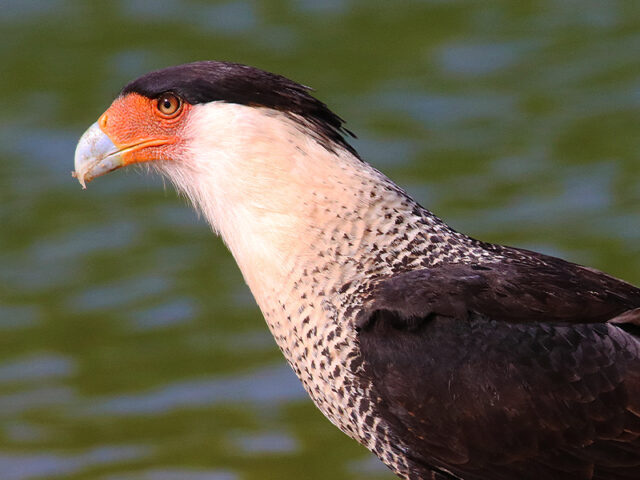
a chance to photograph them as I was with the Bald Eagle!

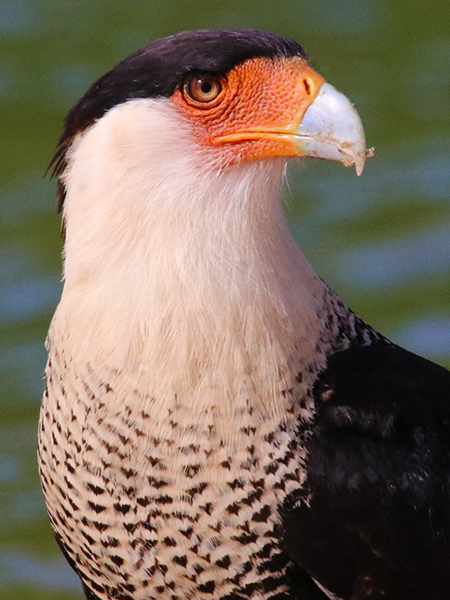
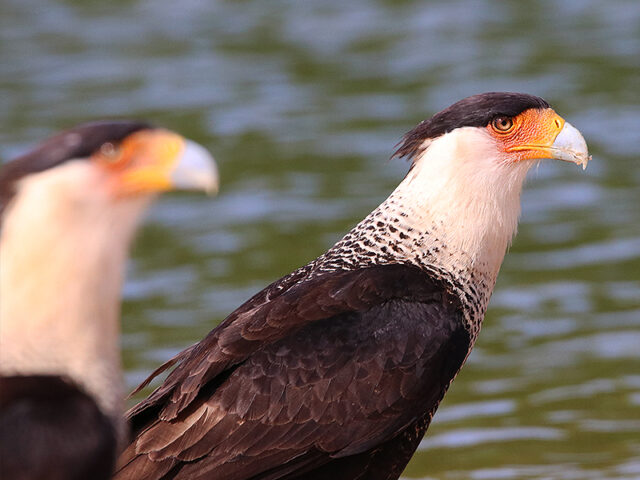

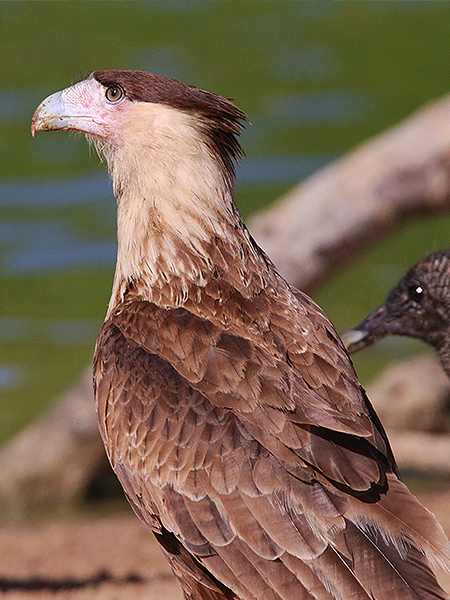
But the Turkey Vulture’s and caracara’s time at the table would not last long. Up above a new group of big birds was marshaling. The Black Vultures had arrived. Turkey vulture often find carrion first, using their heightened sense of smell to guide them in. Black Vultures, on the other hand, simply watch the Turkey Vultures and then follow them to the best finds.
Black Vultures are gregarious and aggressive. When they arrive in large numbers, they have the ability to completely take over any given feeding site. And that’s exactly what happened here. After having only a few minutes to feed, the Turkey Vultures and caracaras were forced to the fringes as the rowdy Black Vultures moved in to gobble up whatever was left.
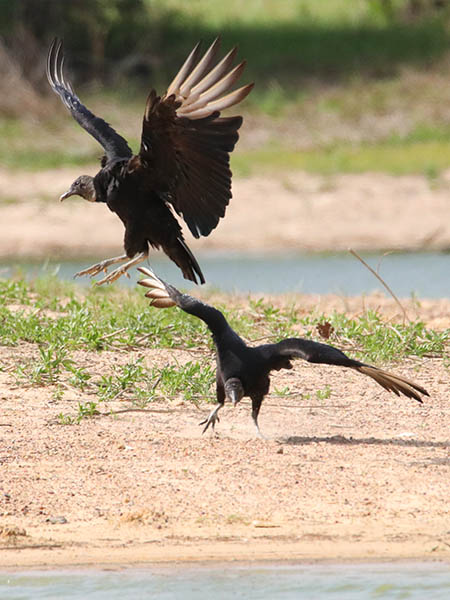

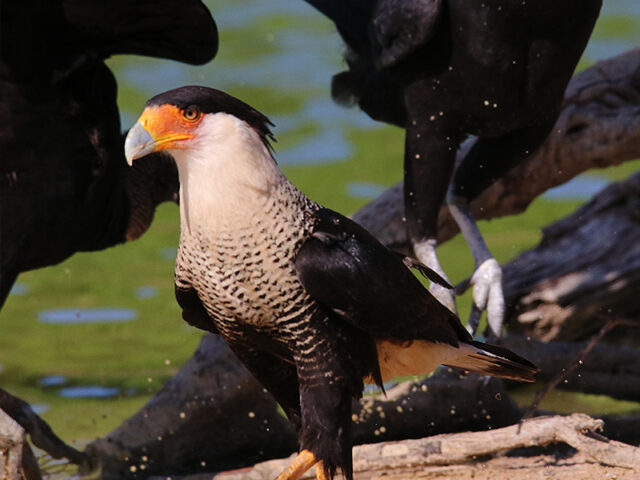
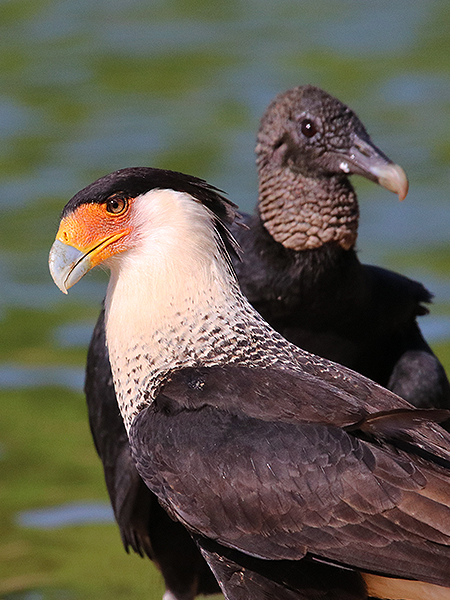
only able to feed for a few minutes before
the Black Vultures arrived and took over
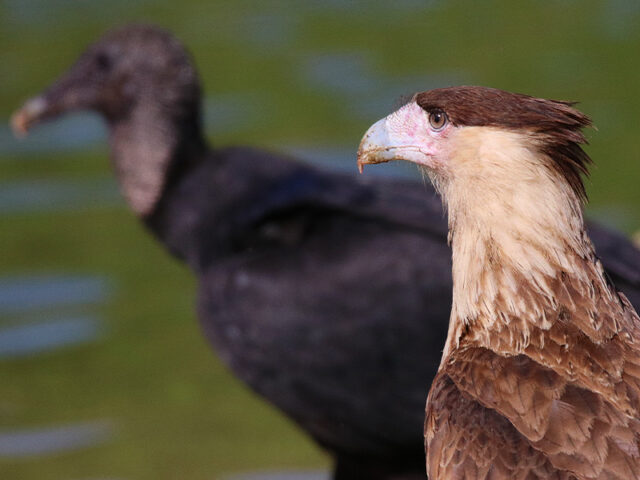
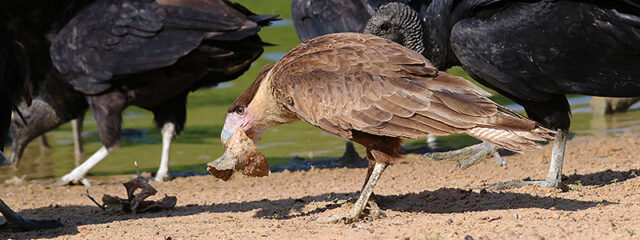
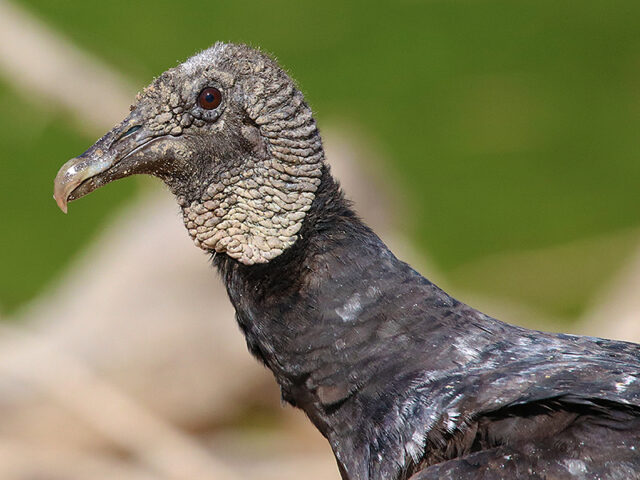
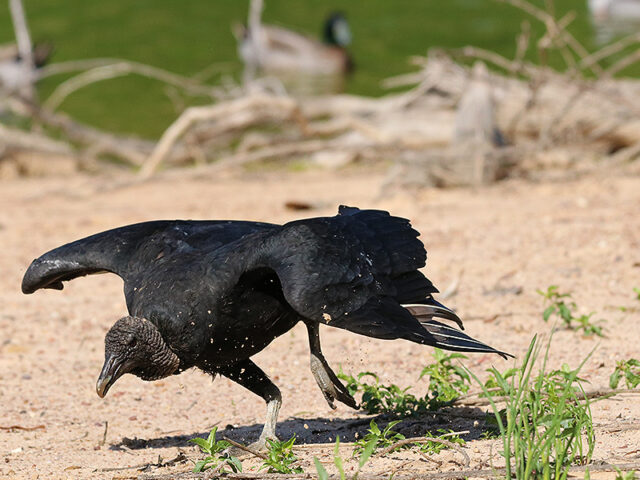
All of nature is special. All is valuable. But for many of us the Bald Eagle represents just a little bit more. These beautiful, majestic birds, along with all of the strength and power the embody, have made an impressive comeback in North Texas in less than the course of a single human lifetime. Their numbers should continue to increase year after year into the foreseeable future. It’s really incredible. All it took were simple and obvious changes in attitudes derived from a new found recognition of intrinsic value, which manifested in just a little bit more respect and restraint. When I was a boy I would have had to travel to the wildest and most remote corners of the continent just have a chance for an experience like this one. Now it is possible in our own backyard. That is truly a remarkable development.
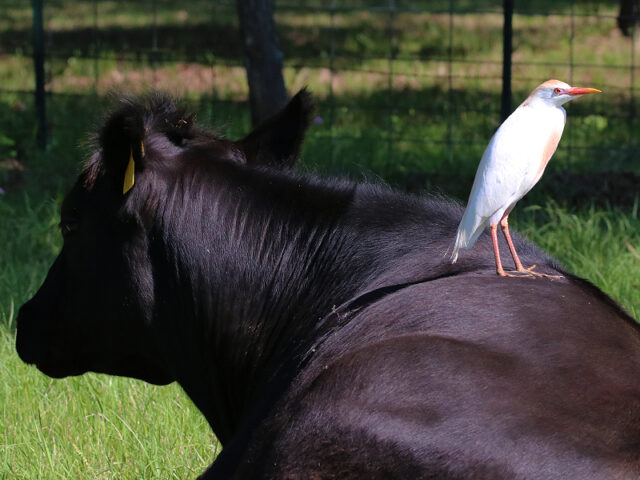
And as you may recall, I made the drive out to Kaufman County in the dark of night. The return trip took place just this side of noon under an immense blue sky. That was a tremendous improvement! There are few things I enjoy more than a drive through the grand Texas back country. I snapped a few pictures as mementos as I made my way home…
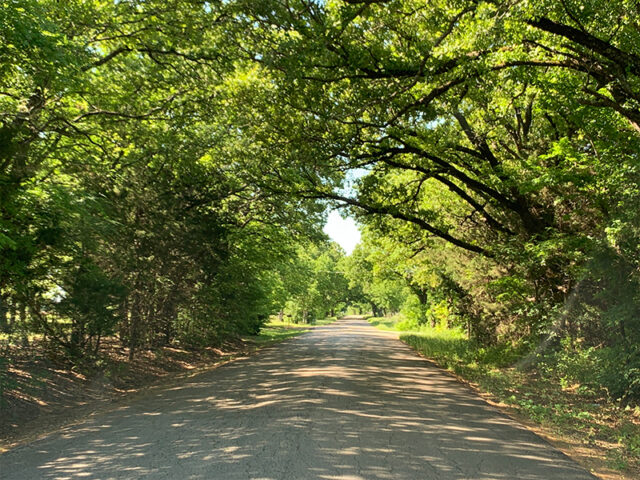




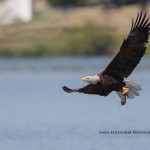
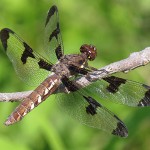



That was well worth the wait! I was holding my breath as I read along.
Chris, this was beautiful. Perhaps your best yet.
A comment about this: “All it took were simple and obvious changes in attitudes derived from a new found recognition of intrinsic value, which manifested in just a little bit more respect and restraint. ”
For the sake of those who are not aware of what you refer to, I would have hoped you would have stated it explicitly. You refer of course, to the use of chlorinated hydrocarbon insecticides, and specifically DDT, which was one of the most important causes of eagle and other large bird decline during the post WWII period. Regulations that banned DDT allowed the bald eagle, the brown pelican, and some other large birds that feed on fish to recover from a pesticide caused decline.
Again, thank you so much for this beautiful photographic essay.
I took a vision of an otter 3 days ago
That’s awesome! I was riding my bike in my neighborhood a few months ago (I’m in Kaufman Co. btwn Terrell and City of Kaufman and our neighborhood in not in the city; everyone has multiple acres) and I saw a Bald Eagle; I told my neighbors who were skeptical and thought it might have been a Mexican Eagle. No, I was sure it was a Bald Eagle. Anyhow, I also just saw two separate posts in the Wildcat Ranch Facebook feed; the responses regarding sightings in the newly opened Wildcat Ranch Park (a bike trail park, Crandall, TX). One person indicated they saw a Bald Eagle there and another replied that he saw what appears to be an eagle’s next on a lake/pond there. I can’t confirm this but def. worth checking out.